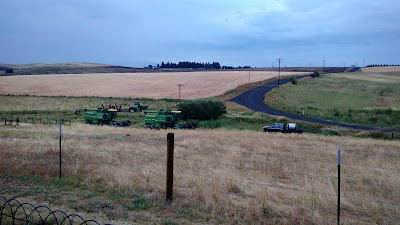On our Easter sojourns to Scotland, Darla's interests and mine are somewhat divergent, perhaps at opposite ends of the tourist spectrum. This is not to say that these are mutually exclusive. Merely that they are different.
 |
| 2019 Darla, Achamore Gardens, Gigha |
She takes sheer joy in growing, beautifying. Indeed, for its location, our Idaho home likely competes with the best of conservatories anywhere. But if there's a wandering eye or ulterior motive in the girl during our trips to Scotland, it's always on the prowl for new gardening designs.
For me, it's about the history, the heritage. As for an immediacy of joyful celebration, that's what pubs are for.
Lord knows the Brits (including Scots) do love to garden. They've an embarrassment of riches. Then again, there's plenty of pubs as well. It's fortunate that our respective interests during our Scottish sojourns often overlap. They do not, in other words, conflict. Well...most of the time.
 |
| 2019 Ogham Stone, Ghigha |
Being off-season the week before Easter, we are
normally in front of the tourist surge, as Europe awakens from its
winter. Beyond the pensiveness we seek in an Easter pilgrimage, practical reasons exist for visiting at this time. Off -season rates are more affordable. Weather is generally good. And, we mostly avoid the crush of tourists from the Continent.
 |
| 2017 Daffodils, Kildalton, Islay |
Gorse (or "whins" locally) is an odd "evergreen" leguminous genus (20 species; Fabaceae family). Common gorse is native to western Europe and the British Isles. Most species of gorse, however, are indigenous to Spain. Between them, gorse is generally always in bloom. In the U.K. during early Spring right before leaf out, little can compete in the view shed with gorse for color. Spring is the height of common gorse's bloom.
More, it is aromatic, with a coconut fragrance that is experienced very strongly by some individuals but only weakly by others. It's a yin yang thing maybe. Darla senses gorse's fragrance strongly. Me?...not so much. They're pretty to look at, so long as it's over there.
 |
| 2019 Achamore, antique equipment |
We have something like this in mind for our place here in Idaho--with our numerous nascent gardens, orchards, plant beds and borders all demanding time and labor.
When the trip to Scotland was abruptly halted under international Covid quarantine 8 days before our Easter 2020 trip was to take place, we set about planting apple and pear orchards, tearing down a couple dilapidated outbuildings and reusing any solid material in putting up an open equipment shed.We also began clearing our pastures of stones, putting those into gabion walls at the entrance to the "W". We are now extending the wall along our south pasture line on the county road. The wall will doubtless be a lifetime task. It seemingly moves at a snail's pace--or rather, it moves at my pace, which basically says the same thing. My herculean effort is probably better suited for younger bodies. So, snail's pace it is then.
By August 2020 last year, the short east side wall at our road entrance was put in. It runs to the picket fence gate which cannot be walled across because it allows field equipment into our back wheat field. And the first couple gabion baskets were started on the west wall work.
 |
| Equipment access to wheat fields |
 |
| August 2020 Extent of the gabion walls |
But, the wall is now a landscape feature, as many neighbors have stopped by while I worked the wall and complemented it. It is definitely more permanent than mere wire.
One might speculate that our mimicking of the quintessential Scottish landscape monuments (i.e. rock field walls) is owed to our nostalgia for Scotland. Perhaps. And yes, it is true that stone walls are everywhere to be found across Scotland's landscape. But actually, our wall building has a practical side.
Scotland has omnipresent stones
that need to be cleared to improve pasture land, as do we. They decided the best
place to put them are in walls. We concur. A nice wall sure beats piles of
clearance rocks dumped randomly around the field perimeter, and in some instances in the middle of the field. Good fences make good neighbors and all.
 |
| October 2021 Wall progress |
At the same time, we have contracted for new siding and windows for the farmstead, upon our return from Scotland. The farmhouse is old and desperately needs to be hardened against the weather, if it can be expected to last another 100 years.
 |
| 2019 The homestead |
As to the wall, neither is that only utilitarian. It has its art.
We intend to continue the gabion wall roughly a quarter mile. The rock wall will serve as a horticultural backdrop for a rim of trees and windbreak plantings. With any luck, and some determination, the landscape feature we are working to put in place should be a joy for generations to come.
That's the inspiration we have taken out of Scotland. Quite a gift is this sense of working to improve the world one stone at a time. One can move mountains that way, we are told. |
| November 2021 Sunset over the vegetable garden |


No comments:
Post a Comment